ECOCIDE
Towing begins of cargo ship ablaze off Dutch coast
THE HAGUE, July 31 — Towing began yesterday of a cargo ship packed with electric cars that went up in flames off the Dutch coast following delays due to weather conditions, authorities said, racing to prevent an ecological disaster.
Movement of the smouldering Fremantle Highway — with nearly 500 electric vehicles on board — began in the last afternoon, early five days after the blaze began, the national water management agency Rijkswaterstaat said.
The ship is slowly being towed some 16 kilometres north of the islands Schiermonnikoog and Ameland, a few dozen kilometres from its last official position.
Saturday’s attempt to salvage the ship was postponed due to high winds that engulfed the rescuing tug in smoke, posing health and safety risks for the crew.
“There was considerably less smoke on the cargo ship this afternoon,” the government agency said, adding the vessel’s stability was constantly being monitored following concerns of it sinking.
The tow could take up to 14 hours depending on weather conditions, smoke and the tide.
The cause of the fire that broke out late Tuesday remains unclear, although the vessel’s owner has said one of the electric vehicles on board may have been the source.
The Fremantle Highway was located in the Wadden Sea at the time of the blaze, raising concerns about the impact of pollutants on the waters and nearby archipelago of ecologically sensitive islands.
One sailor died after he and 22 others were rescued from the burning ship that had forced some crew members to jump overboard.
— AFP
Dutch Salvors Begin Tow of Fire-Ravaged Car Carrier
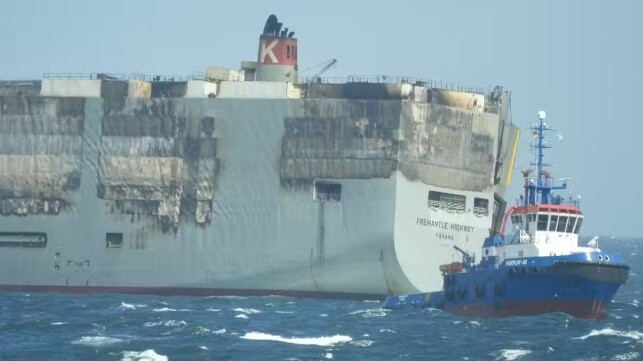
On Sunday afternoon, the fire aboard the stricken car carrier Fremantle Highway finally subsided enough that the burned-out vessel ceased smoking, allowing salvors to begin a towing operation to bring the hulk to a safe location for damage control and inspection.
The salvage team established a secure tow connection to the vessel's stern on Friday, linking up to the tug Fairplay 30. On Sunday, taking advantage of reduced smoke, salvors made up a tow line to a second tug. The car carrier is now under way with both tugs pulling at about three knots, accompanied by the Kustwacht response vessel Guardian and the pollution control vessel Arca.
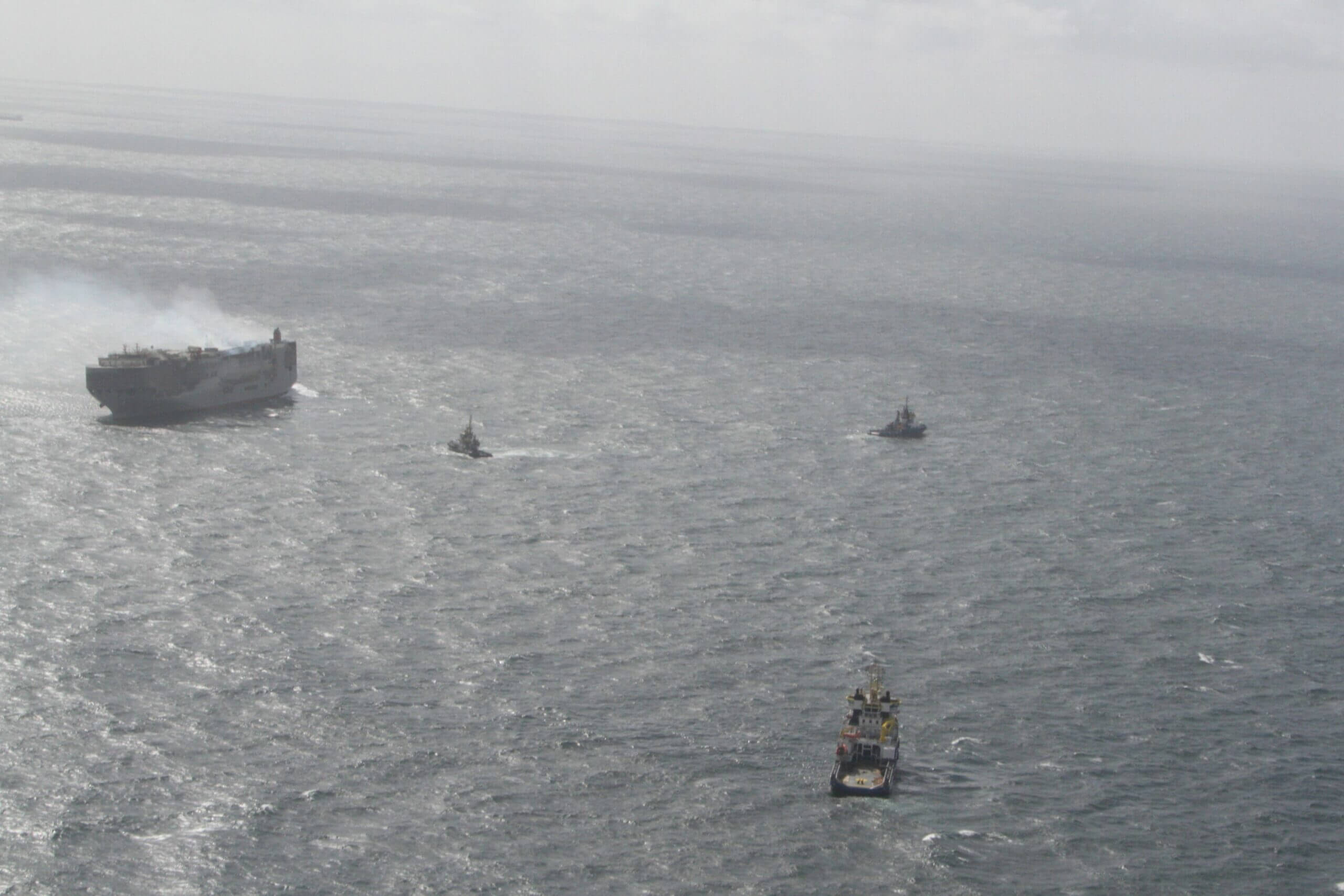

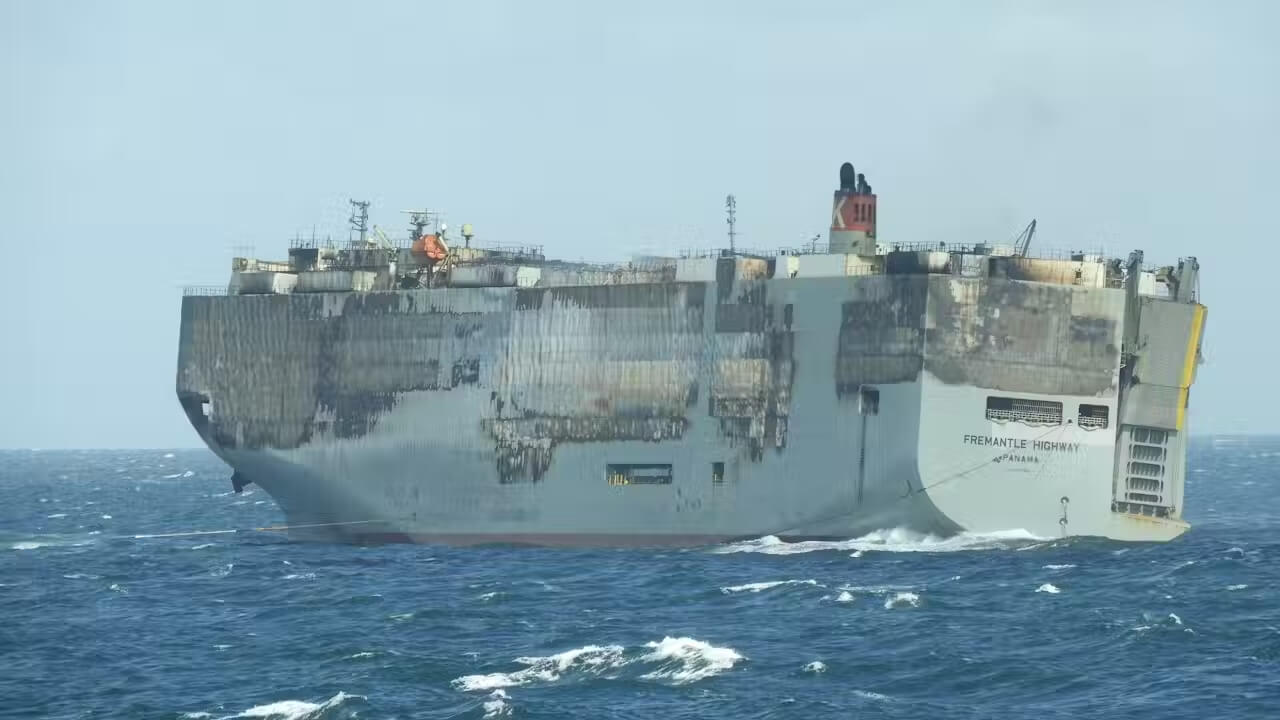
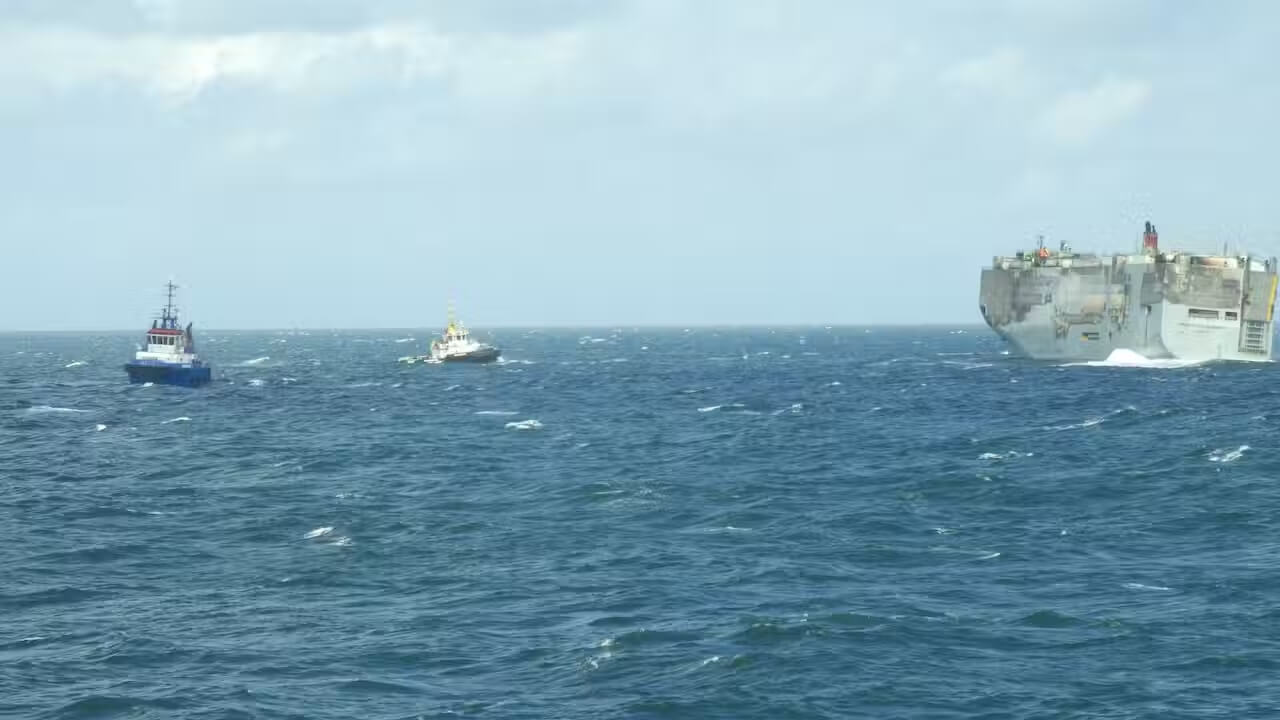 Salvors wait for the smoke to die out, July 30 (top) and finally begin the tow (bottom) (Kustwacht)
Salvors wait for the smoke to die out, July 30 (top) and finally begin the tow (bottom) (Kustwacht)
Once the vessel has been towed to the new temporary location, the tugs will remain connected for control and position-keeping. A periodic airborne watch will monitor for any possible pollution. So far, no releases of oil have been observed.
As soon as the situation aboard the ship allows for a safe tow into port, Dutch maritime authorities would like to bring it alongside a pier to complete salvage operations. The relocation in progress on Sunday is an interim step in the process.
The operation would have started on Saturday, but the wind direction and the continued smoke from the vessel prevented it. The orientation of the tow would have put the tugs in the path of the smoke, increasing risk to the health and safety of the tug crews. The same southwest wind continued Sunday; it was only the eventual cessation of the smoke that allowed the team to proceed.
Based on photos provided by the first responders, the Fremantle Highway has taken on a slight list to starboard. The patterns of paint burn-off cover most of the port side and half of the starboard side, indicating that the fire swept through most of the ship's car decks above the main deck level, from bow to stern. Photos taken Saturday show heavy smoke pouring from the aft-most upper decks, but the paint largely intact; by Sunday afternoon, the paint in this location was gone, indicating that the fire continued to burn at high temperature as late as Saturday night.
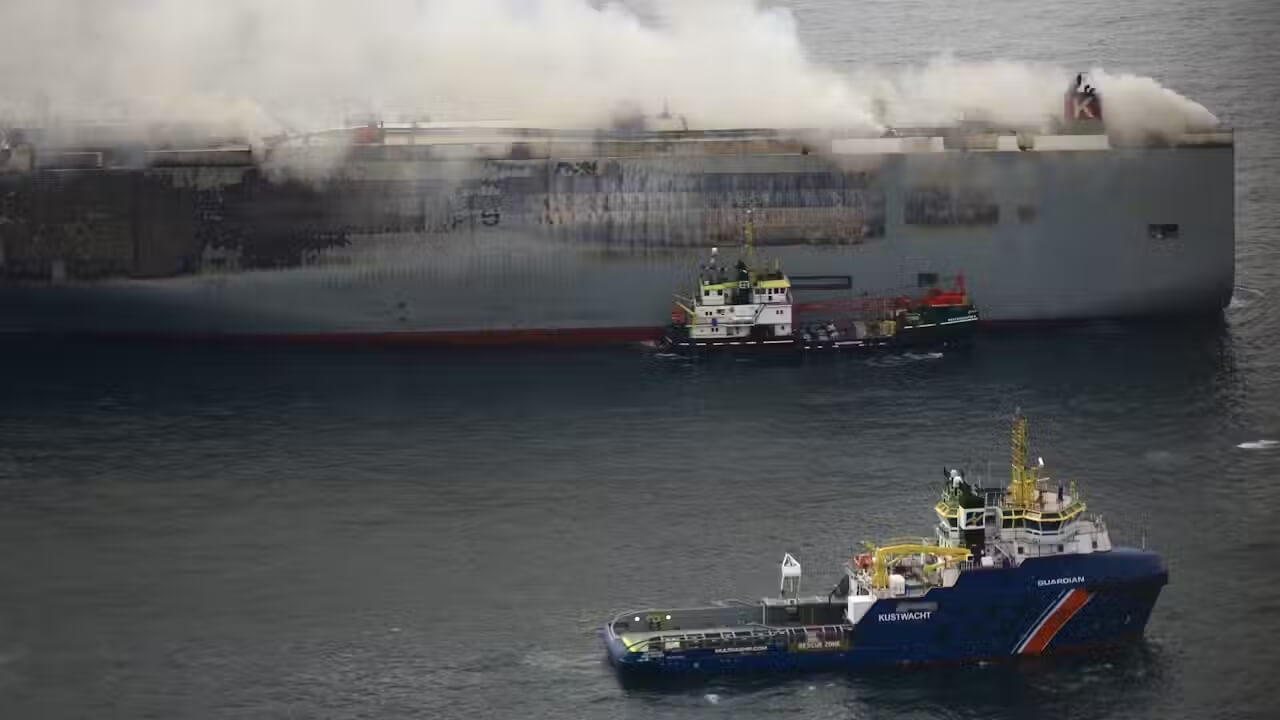
Smoke pours from the stern of the Fremantle Highway, July 29 (Kustwacht)
A thorough evaluation of the extent of the damage will have to await a boarding and inspection of the vessel.
The cause of the fire is not yet known for certain, but the presence of electric vehicles has sparked a minor controversy. Initial reports indicated that there were 25 electric cars aboard out of 2,857 total; in an updated report Friday, K Line clarified that there were 498 electric vehicles aboard out of 3,783 total.
Owner Shoei Kisen Kaisha told the Dutch broadcaster NOS that “there is a good chance that the fire started with electric cars.”
Efforts Underway to Begin Towing Burning Fremantle Highway Car Carrier
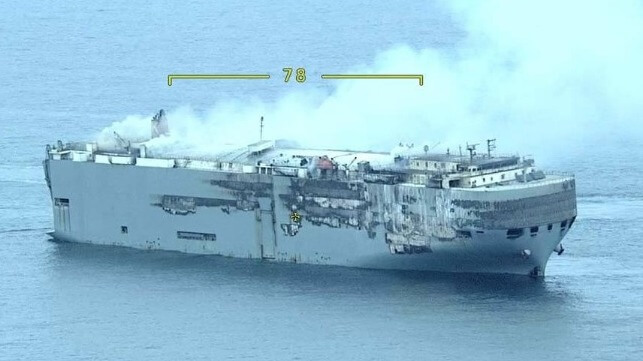
With the intensity of the fire aboard the car carrier Fremantle Highway continuing to dissipate, Dutch authorities announced late today that they are preparing to reposition the ship in the first of a series of steps that they anticipate will ultimately bring the wreck to a still to be determined port. As they were reporting progress with the fire aboard the ship, a new controversy is developing over the number of electric vehicles and total number of cars aboard the ship, leading to further speculation that EVs are a major contributing factor to the fire that has now burned for four days.
“Rijkswaterstaat and the salvage companies have now started preparations for towing the freighter to an area further east than its current position,” the Ministry of Infrastructure and Water announced shortly before midnight on July 28. They have been working closely with the Dutch Coast Guard and the private salvage company hired by the owners of the car carrier since the fire was reported shortly before midnight on July 25.
The timing of the movement of the hulk will depend on several factors, including the level of smoke coming from the ship and weather conditions. The goal is to bring the ship from its current position approximately 14 miles north of Terschelling to a new position approximately 10 miles north of Schiermonnikoog. It will be a move of about 35 miles to the east that they anticipate will take between 12 and 14 hours to complete.
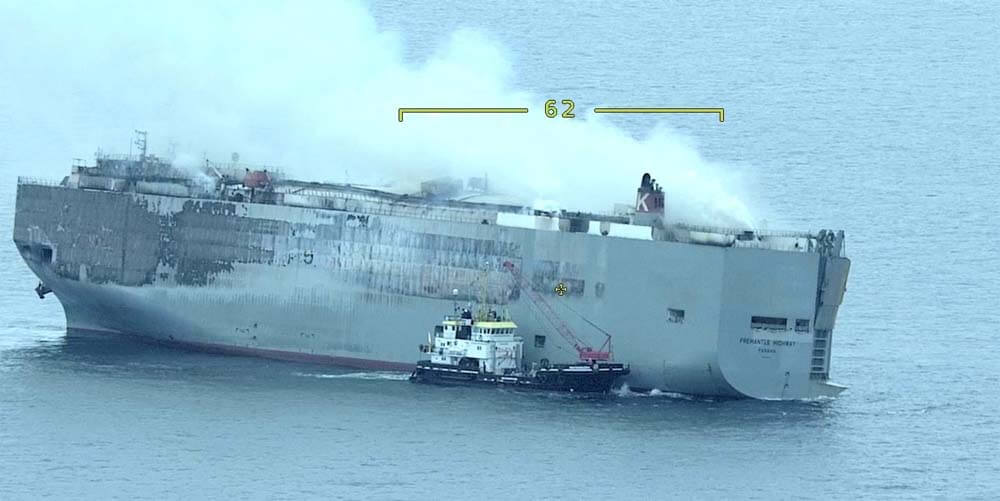
Rijkswaterstaat consulting with the salvage team believes the move is possible because the Fremantle Highway while showing a list is stable and there are no signs of damage below the waterline. They believe the vessel is not in danger of heeling over at this time, but as a precaution, their oil recovery ship Arca continues to stand by and will accompany the tow.
Once the vessel has been repositioned, they will consider further steps. The goal is to continue to move it from the new temporary position and they expect it will soon be possible to tow the ship to a port.
These developments came as they reported that while the fire is still burning aboard the Fremantle Highway it continues to dissipate. Measurements of the temperature on board the ship showed that it dropped sharply during the day and the level of smoke continues to decline. They reported similar findings yesterday after stopping the cooling efforts. They have however said that they were waiting for the fire to burn itself out.
As the intensity of the fire dissipated today, the salvage team was able to briefly place four of its members aboard the vessel. They were taken to the Fremantle Highway aboard the Multrasalvor 4 and only remains aboard for a short period. While they were aboard, they were able to secure a stronger towline strung the Coast Guard reports from the top of the ship and now attached to the Fairplay 30. The earlier line they had previously said was only capable of being used to hold the vessel in position and was strung from a connection lower on the hull.
The new strong connection will aid in the next phase of the efforts. They are currently using it to hold the vessel in position outside the busy shipping lanes. However, it will also be able to support the planned towing operation.
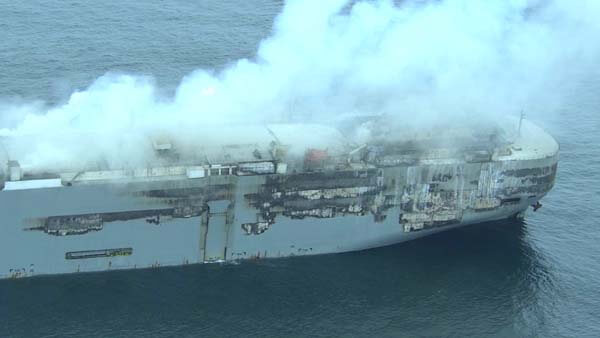
The authorities continue to caution that the origin of the fire is unknown, but today a spokesperson for the vessel’s charter operator K Line of Japan revised earlier reports about the number of vehicles aboard the ship. The Coast Guard using the available manifests said at the beginning of the incident it believed there were 2,857 cars of which only 25 were electric vehicles.
Both Reuters and Associated Press are quoting a spokesperson for K Line, Pat Adamson, saying the accurate number is 3,783 vehicles. They are saying the number includes 498 battery-electric vehicles.
Previously, both Mercedes and BMW confirmed that they had vehicles aboard the vessel. It is unknown what quantity of vehicles or if they were gasoline or electric. The ship was reportedly carrying both new vehicles and secondhand cars. The AIS signal shows that it was bound for Port Suez while K Line said the destination was to have been Singapore.
A fire is still burning on board a car-carrying cargo ship near a sensitive Dutch bird habitat
https://plawiuk.blogspot.com/2023/07/ecocide-fire-is-still-burning-on-board.html
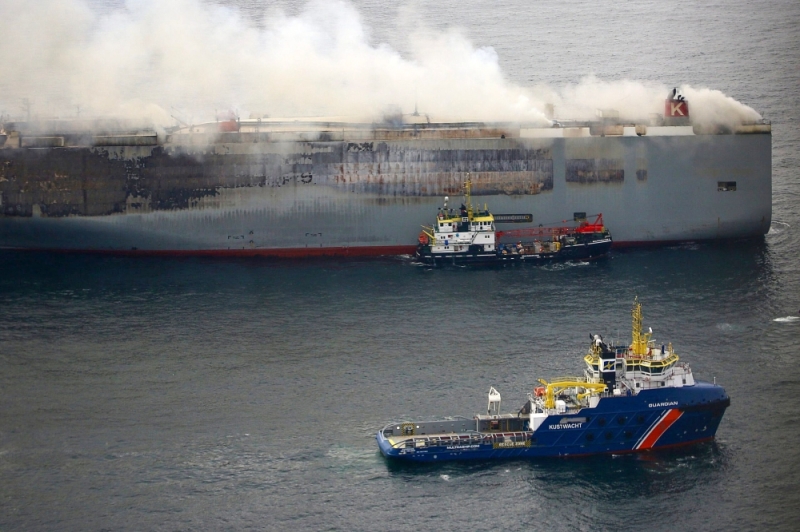
No comments:
Post a Comment